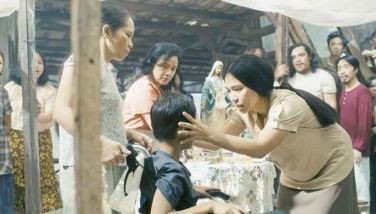Difficult but engrossing opera on Bonifacio
We have to admit that what had drawn us to watch the experimental opera San Andres B was the combination of writer, musician and director, whom we had met way back in the early 2000 on different occasions.
In 2005, we met Floy Quintos who wrote the unforgettable Tanghalang Pilipino production of the musical Saint Louis Loves dem Filipinos, which Alex Cortez directed. Today, Floy is directing San Andres B which National Artist for Literature Virgilio Almario wrote, and Chino Toledo has put to music.
“San Andres B is new in the sense of not being a historical chronicle of Bonifacio’s life, but rather a re-imagining of what might have been had things gone as Bonifacio wanted. In celebrating the 150th birth of the Supremo of the revolution against Spain, the story has Dondi Ong and Margarita Roco star as Andres Bonifacio and Gregoria “Oriang†de Jesus.
From the opening non-melodic, non-linear strains of the orchestra, we could gauge that we were in for a different kind of Andres story and treatment. We are reminded of Mario O’Hara’s film Ang Paglilitis ni Andres Bonifacio in 2010 which had similarly broken ground. Both made use of Bonifacio’s background as an actor in local theater; both dealt with their personal dilemma just as intensely; and both established from the very start that the audience might not like what they would see.
At the Cinemalaya showing of Paglilitis then at the Cultural Center of the Philippines (CCP), the audience started sneaking out after half an hour. At San Andres B, also at the CCP, they started leaving even earlier. Was this the price genius has to pay? Of course! We need not have asked.
If the audience of O’Hara had found his Paglilitis story treatment weird, that of San Andres B found the weirdness ensconced basically in the music. In an interview by Amadis Guerrero, we learned that when faced by the dilemma of what kind of music to utilize, composer Toledo decided to go the way of some opera convention used by older operas like Verdi. The libretto by Almario called for an inner struggle on whether he would follow his conscience and become a “hero,†or just take things as they come, and live a less stressful family life. He had so many things to consider, especially now Oriang, his beloved wife was pregnant.
The audience is inundated by continuous chantings of Toledo’s Mahirap Maging Bayani that follow Bonifacio’s every move in the opera. Delivering Toledo’s messages is a newly-formed 21-piece chamber music orchestra that calls itself Grupo 20/21 as well as the 16-member chamber vocal ensemble called Auit. They were both discovered, trained and put together for the San Andres opera, with Grupo doing its initial project.
Not only was the music alien and problematic to connect with, the libretto itself by Almario, known by his nom de plume Rio Alma, is written in metaphors difficult to swallow. We experience pain in our abdomen, a usual condition we have come to associate with our own lack of understanding. All we have deduced from this experience is that the opera San Andres B is a coming of age and awakening of a country from a deep slumber of 300 decades under the Spanish rule, several other centuries under the Americans, Japanese, with the resultant effect of our own mis-education. And that time has come for us to realize our own significance in this world, no matter how painful the process of realization may be.
In today’s society, we ask ourselves, just how has the Filipino progressed? Beyond being the gentle Asian, loving and happy people who will offer their homes to every interloper; beyond being celebrated as the newly-discovered singers and musicians of the world, what have we become? We need to answer this question honestly. And also the next question whatever the price, whatever the hurt?
(E-mail your thoughts to [email protected]. or text to 0917-8991835. Performance runs until Dec. 8 at CCP.)
- Latest
- Trending




























 Exclusive
Exclusive




